Chin Rest: Adjustable in all directions
4. Angle and Shape
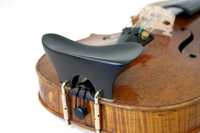
When the angle or shape of the chin rest was not correct, it meant that the jaw could not get a proper grip on the chin rest. As a result the musician had to make extra searching movements with the neck and jaw, making them struggle for a useful contact with the chin rest. When the chin rest cup was too roomy or deep for the player’s jaw, then the edge of the chin rest often pressed into the player's throat, missing the jaw bone altogether. This contact provided the player with little help in supporting the instrument. It was also uncomfortable and unhealthy, as it pressed on the soft structures of the throat; many players had developed sores on the skin where the chin rest had rubbed. The edge of the chin rest must match the contour and depth of the jaw bone, in order to provide the jaw with the grip needed, without pressing or rubbing elsewhere.
Before the research:
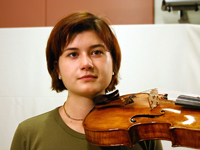
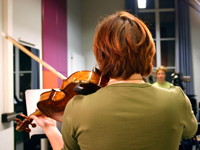
1. Monica’s old chin rest had a very deep cup that did not fit her square jaw shape.
2. She had to twist her neck and grab with her jaw to get a grip, which caused chronic neck pain.
After the research:
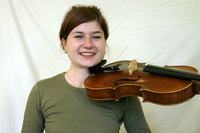
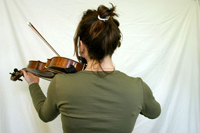
1. Monica’s chin rest is adjusted to fit her jaw shape.
2. Now she can get a grip on her chin rest without twisting her neck. Playing is no longer a “pain in the neck.”
We could experiment to find the right shape and angle of the chin rest for each player by using the latex inserts of the Chin Rest Testing Kit, which worked like shoe insoles. The desired angle and shape of the chin rest was then incorporated into the design of the final custom chin rest made for each player.
Tip: How to raise or tilt your own chin rest
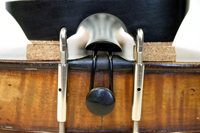
Raise: You can raise your chin rest up to about a centimetre and still have it remain stable enough to play. (Some players need more adjustment in height than 1 cm.) Before the research, we used to raise the chin rest using wine corks, or more solid “hobby” cork.
You can create room to insert the cork between the violin and the chin rest by substituting longer barrel screws for those that come on your chin rest clamp. The barrel screws which are made for viola come in different sizes, and can be used by violists and violinists alike to make the necessary space to fit corks under the instrument.
Tilt: Wolf Productions also makes independent screw feet, which you can screw directly into your chin rest. These independent feet allow you to insert corks of different heights if you wish to also tilt your chin rest.
Note: These tips are for trial purposes only. We found the only true solution was to have your own chin rest made, taking into account height, tilt, angle shape and position.
